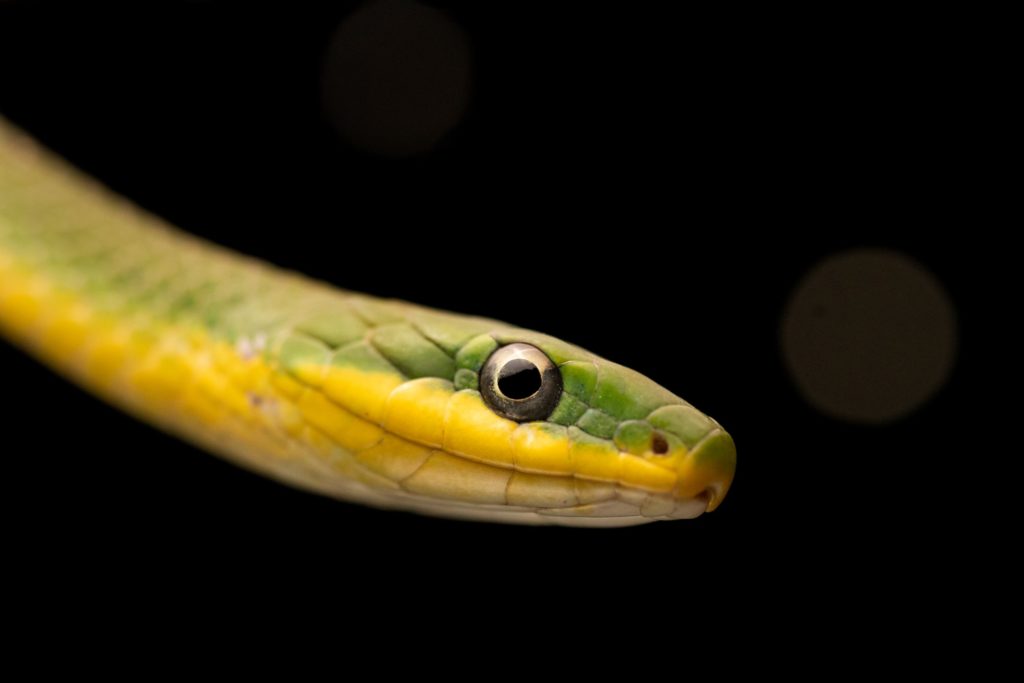In this Rough Green Snake care guide, we’ll take a look at how to keep them happy as pets. Though small, they make a refreshing alternative to nocturnal snakes.
Last updated on February 1st, 2023 at 09:38 am
Are Rough Green Snakes good pets?
Rough Green Snakes (Opheodrys aestivus) are a species of arboreal Colubrid snake that have a huge range in North America. As a highly successful species, they are common throughout most of their distribution.
Asides from being widespread and common, they are also small and hardy enough to make great pets. Notwithstanding, they are almost the exact opposite of most popular pet snakes. While Ball Pythons, Milk Snakes and Boas are nocturnal rodent feeders that are fun to handle, Rough Green Snakes are diurnal invertebrate predators that are a pet to observe, rather than interact with.
In this care guide, we’re going to look at their size, diet, lifespan, enclosure requirements, heating and pretty much everything else you need to know to keep them healthy and happy. We’ll also look at some tips on how to find captive-bred snakes for sale.
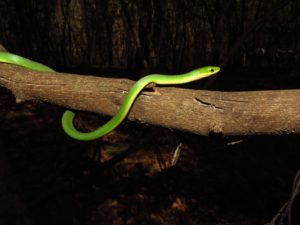
Rough Green Snake Size
One reason that this species is a good pet is its small size. There are a lot of amazing arboreal species out there, but what puts people off some of them is there size. Scrub Pythons (Simalia amethistina), for example, are semi-arboreal but get absolutely huge. Yellow Rat Snakes (a population of Pantherophis alleghaniensis) are hardy and cheap, but again, regularly reach 5ft in length (1.5m).
With Rough Green Snakes this really isn’t a problem. Their average size as adults is a very slender 24 to 32 inches (60 to 81cm). In fact, I would consider an individual over 36 inches (90cm) to be extremely unusual. As with many egg-laying species, females may be larger than males.
Hatchling Rough Green Snakes are tiny and start out at 7 to 8 inches in length (18 to 20.5cm).
Rough Green Snake Lifespan
Generally speaking, smaller species of Colubrid do have slightly lower lifespans. Nonetheless, you can expect a Green Snakes to reach 8 to 12 years of age in captivity. Occasionally, they can reach 15 years of age or slightly more if cared for very consistently. This boils down to quality of food, husbandry, equipment, and hygiene over the years.
As with many species from temperate zones, Green Snakes do brumate (hibernate) for two or three months in the wild. Many keepers believe that brumating pet snakes extends their lifespan, and with some very northerly species this can be true.
With southern species such as this, brumation may only last for a month or two, however, making it less of a factor. Personally, I would only brumate Rough Green Snakes to stimulate them to breed, in which case it is a necessary. Otherwise, I would avoid the added risk of cooler temperatures.

Green Snake Enclosure
Rough Green Snakes are consistently arboreal throughout their range and need an enclosure that reflects this. In the wild, their habitat consists of dense brush and tree edges, usually along the banks of rivers and ponds. They spend their days weaving through the branches and vines, stalking bugs, and mimicking the wind to avoiding detection by predators.
At night, they generally climb to the top of a large shrub or tree and sleep there. This is similar to how Common Chameleons sleep and is probably a good way of avoiding nocturnal predators.
When making a tank setup for this species, you need to keep these behaviours in mind. Branches are their hunting ground, bed, and hiding place all in one. They need to have branches to perch on at various heights within the enclosure so that they can fulfil these behaviours.
Whether the branches you use are real or fake, it really doesn’t matter. But they do need to at least look real. What I would say is that unlike Ball Pythons, Green Snakes make small messes and are great candidates for bioactive setups.
As I’ve said before, I don’t like plugging products in these articles, but from what I can see, the best tanks for keeping this species are the Exo Terra arboreal Terrariums. I strongly suggest checking them out or finding similar enclosures.
A lot of people are using all mesh enclosures for these snakes, but I wouldn’t recommend this unless you live in an area with naturally high humidity (more on this in the Humidity section!).
Let’s take a look at a nicely designed, naturalistic Rough Green Snake enclosure that I feel is ideal.
Rough Green Snake Tank Size
Tanks for this species should be kept to a reasonable size. For one or two adults, I recommend a tank that is around 2 to 3ft (60 to 90cm) high, by 18 to 24 inches (45 to 60cm) wide and deep. For hatchlings, it is better to start them off in a smaller tank, tub or terrarium so that you can observe them more easily to keep track of their health and feeding.
If you provide this species with an enclosure that is too big, you will never see it! It really is that simple. They like to blend in and are incredibly good at it.
Lighting: Do Rough Green Snakes need UVB?
There have been so many times where I’ve seen people debating online about which snakes do or do not need UV lighting. It’s a simple subject with a simple answer: diurnal snakes that spend all day out in the open need UV!
Rough Green Snakes are no exception and will require full spectrum UVB and UVA lighting to metabolise Vitamin D3. If you do not provide it, they will either develop health problems such as metabolic bone disease or die prematurely.
When providing UV lighting, bear in mind that most bulbs need replacing every 6 to 9 months. I usually write the date of installation down or put a reminder on my calendar so that I won’t forget.
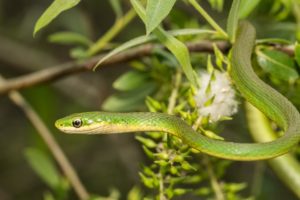
Heating
In the US, Rough Green Snakes can be found all the way from the New Jersey Pine Barrens to eastern Texas, but no further north than 40° latitude. They also occur in extreme north-eastern Mexico.
If you’re familiar with the US, you’ll notice that this range encompasses all the warm, humid regions of this part of the world. For optimum health and activity levels, you need to mimic this both day and night.
For daytime temperatures, I recommend a basking area temperature of 85 to 90f (31 to 32c) and an ambient temperature of 78 to 85f (25.5 to 31c). At night, the temperature throughout the enclosure can drop to 70 to 75f (21 to 24c).
My recommendation is that you use an “all-in-one” basking light for daytime. These emit both basking heat and UV light, and are available from several manufacturers such as Arcadia, Zoomed or Exo Terra. You may also see these advertised as mercury vapor bulbs.
If you have trouble keeping the terrarium warm enough at night, then your best option is a ceramic heat emitter.
Measuring and regulating temperature
The basking light should be plugged into a timer. The idea is to provide 12 hours of daylight, then 12 hours of night. If using a ceramic heat emiter for nighttime heat, you must also use a pulse-proportional thermostat, and place the probe in mid-air, near the top of the enclosure but not directly under it.
For the daytime basking light, you could use it with a dimming thermostat, and place the probe a few inches below it. The drawback with this method is that you really want the full UV output at all times – dimming it when it gets too warm is a waste.
Preferably, you can simply measure the distance between the bulb and the basking area to figure out how much it will heat it. Many of these basking bulbs will give a 90f (32c) basking temperature about 8-12 inches (30cm) below them. One example is the 80watt Exo Terra Solar Glo, which you can read more about here.
So, you may not need a thermostat for the basking light – but you will need a ruler and some careful planning.
With either method, you will need to use an infrared thermometer gun to check your basking spot temperature, and a digital thermometer to check the ambient temperature.
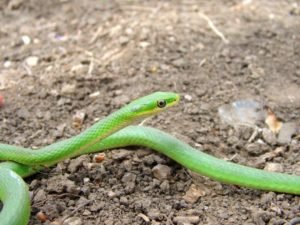
Humidity and water
As I mention earlier, Opheodrys snakes are from warm, humid climate zones. They also tend to frequent the edges of bodies of water. It seems that relatively high ambient humidity is important to them for good shedding and hydration.
In the enclosure you should aim for a humidity level of roughly 70%, as well as a humidity gradient. This can be achieved by providing humid areas full of sphagnum moss in the bottom of the enclosure and misting one half of the enclosure on a daily basis if the humidity gets too low. At same time, you can let the basking area get a little drier.
By doing this, you can let the snake choose how damp or not it needs to be. This is important because although they enjoy reasonably high humidity, they also enjoy basking high-up where there is a gentle breeze.
You must also provide clean, non-chlorinated water for your snake at all times. Ideally, it should be changed every few days. Like Green Tree Pythons, Green Snakes will drink out of a bowl despite being arboreal.

Diet
Rough Green Snakes are mainly invertebrate predators, although they will accept the occasional small lizard or frog. In general, they do best when fed as much variety as possible.
Whereas rodent predators like Bull Snakes and Green Tree Pythons get all the nutrients they need from one prey type, invertebrate predators need several for their diet to be complete.
The best foods for captive Opheodrys are grubs, caterpillars (such as hornworms), grasshoppers and crickets. These can all be bought from pet shops or online and are very nutritious when gut-loaded. Gut-loading is the practice of giving feeder invertebrates a vitamin supplement in their diet before feeding them to your reptiles.
Don’t be afraid to ask the supplier about this – there’s no point feeding prey that hasn’t been well-fed in the first place! If your supplier doesn’t gut-load their invertebrates, you should give them a gut-loading diet for a week or two before feeding. Gut-loading products are easy to find online these days so it won’t be a problem.
Again, you must ask your supplier about this, you don’t want to over-supplement your snake. Over-supplementing reptiles is just as dangerous as malnourishment and it is best to follow the advice of a dedicated reptile food supplier.
Note: you can read a more about what to feed this species in our Rough Green Snake diet article.
Do Rough Green Snakes like to be held?
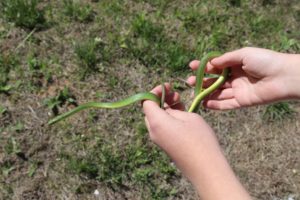
It’s a flat no on this one guys. These snakes are gentle, harmless, and reluctant to bite. They do not enjoy being handled though! Being as small and delicate as they are, Green Snakes are very prone to stress from over-handling. This can result in them hiding constantly or even dying.
All-in-all, this is a species to observe rather than handle. But the fact that they are diurnal and arboreal means that observing them can be very enjoyable.
Are Rough Green Snakes social?
I wouldn’t go as far as to say that these snakes are social – but they do tolerate each other and can cohabitate without issues. In fact, a lot of keepers have reported no added stress or health issues from keeping Green Snakes together.
The only drawback is of course that if one gets sick, they all will. In the event of a trip to the vets, you’d be looking at a slightly larger bill. If you follow the advice in this care sheet, and buy captive bred, then there is no reason for them to get sick though. Overall, I wouldn’t let this small risk put me off keeping several of these snakes in the same enclosure.
Rough Green Snakes for Sale and price

First and foremost, please, please, please buy captive-bred if you can. Despite being common in the wild, they are heavily exploited for the pet trade, and we all know it can’t last indefinitely. Moreover, wild caught snakes are often a rip off. They usually come with internal parasites, an overload of stress, and many other problems that can make them very short lived.
Fortunately, they are being produced in captivity by some dedicated breeders these days. If you do your research, you can find these people in online reptile forums, and occasionally on resources such as Morphmarket.
In general, Rough Green Snakes are a very cheap species, and never cost more than $50-80. You should, however, factor in the price of their enclosure and lighting if you plan on buying one.
Facts and Care Summary Table
| Common names: | Rough Green Snake, Keeled Green Snake |
| Scientific name: | Opheodrys aestivus |
| Distribution: | South-eastern US, north-east Mexico |
| Activity rythm: | Diurnal |
| Habits: | Arboreal |
| Habitat: | Dense vegetation near water |
| Temperature: | Basking 85 to 90f (31 to 32c), ambient: 78 to 85f (25.5 to 31c) |
| Humidity: | 70% |
| Favourite food: | Grubs, caterpillars, crickets |
| Enclosure size: | 2 to 3ft (60 to 90cm) by 18 to 24 inches (45 to 60cm) |
| Lighting needs: | UV essential |

